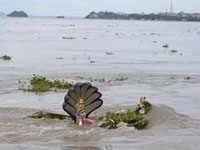
Assam floods: Toll climbs to 34
Guwahati: Flood situation in Assam continued to remain grim on Monday with three more persons losing their lives, taking the death toll to 34 in the current deluge in which over 11 lakh people have been

Guwahati: Flood situation in Assam continued to remain grim on Monday with three more persons losing their lives, taking the death toll to 34 in the current deluge in which over 11 lakh people have been
Massive outbreak of bird flu in the neighbouring state of West Bengal has sent alarm bells ringing in Assam. As epidemics know no geographical barriers, adequate precautionary steps are the only way to combat it. To keep the dreaded bird flu at bay, the Animal Husbandry and Veterinary Department of the State has undertaken a slew of measures. The steps include ban on import of poultry products and free poultry zone in the two border districts of Dhubri and Kokrajhar. The move to create a free-poultry zone has resulted in mass bird culling operation in the two border districts.
Although the State Government has declared some villages as "model village' from time to time its apathy towards them has raised a question mark about the Government's sincerity in making these villages as model villages. Jhaskal village under Satrasal GP in Dhubri district located in the far-western Part of the Indo-Bangla International border is a glaring example of underdevelopment. After 21 years of its declaration as a model village, Jhaskal area is still to see the light of development in communication, healthcare, education power supply, agriculture etc. Situated under Agomani Development block in Golakgani LAC, Jhaskal was formally declared as a model village and its foundation stone was laid on April -11, 1987 by the then Chief Minister of Asom Prafulla Kumar Mahanta. Though the people of the village are largely dependent on agriculture, they are deprived of the modern methods of agriculture including superior quality seeds, manure etc. Even the peasants do not get the right price for their produced goods. The education scenario in the village is also grim. The two ME schools established 22 years ago through public donations are yet to be provincialized by the Government. Great Jhaskal area has four Government LP Schools. These schools lack basic infrastructure like desks and benches. In comparison to students enrolment, there is also shortage of teachers. Three schools are still running with a single teacher each. In the name of healthcare, there is a sub-centre at Jhaskal but its lacks adequate nurse and medicines. As a result, for simple disease, the patients have to rush to Satrasal or Agomani for treatment. Road communication in the area is also very deplorable. In the monsoons due to lack of repair work, the village roads become muddy and waterlogged. Though there was a PWD road through the villages in the past, it was declared as a border road in 1985 at the time of fencing of barbed wire across the Indo-Bangla border resulting in a lot of troubles to the border people. Now, the villagers have to use the road as per the time and permission of the BSF. If not, they have to face action from them. Another grey area of this "model village' is power. The transformer remain out of order in majority of the days in the year making the villagers the worst sufferers. The village is also deprived of potable water. Though a Public health and Engineering scheme was launched at jhaskal Part -1, the people are deprived of its service. After six months of service, the scheme is lying abandoned for 19 to 20 years. It is worth mentioning here that several hundred bighas of lands in the area fall into India's side of the